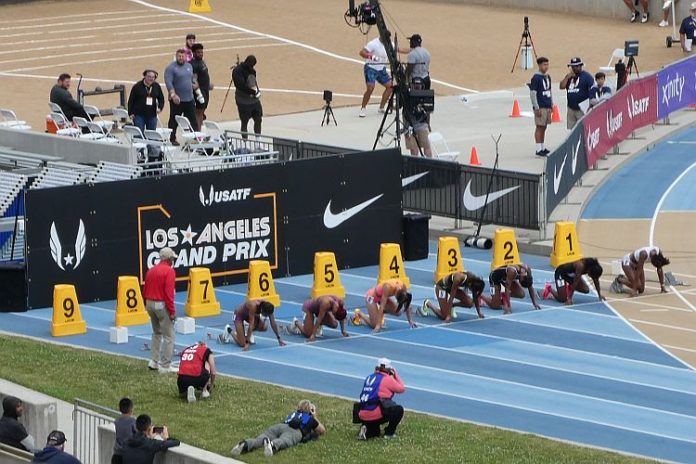★ The Sports Examiner: Chronicling the key competitive, economic and political forces shaping elite sport and the Olympic Movement.★
★ To get The Sports Examiner by e-mail: sign up here! ★
★ Friends: This site is free, but we have expenses, especially for technical support. If you can support our coverage, please donate here. Your enthusiasm is the reason this site continues. Thank you. ★
In many ways, track and field has never been better. Brilliant athletes like Noah Lyles, Jakob Ingebrigtsen, Mondo Duplantis, Ryan Crouser, Sha’Carri Richardson, Femke Bol, Faith Kipyegon, Sydney McLaughlin-Levrone, Tara Davis-Woodhall and many more are tearing it up on the track and on the infield.
But then there was McLaughlin-Levrone, speaking at the end of May to Anderson Emerole of The Final Leg in a short video shared on X (ex-Twitter):
“I feel like we don’t do a good job marketing ourselves, especially in the U.S. market. We need more TV deals, we need people to actually be able to see our sport and not have to pay all the time to watch subscriptions online.
“That’s just my opinion.
“I think the Netflix documentary [six 45-minute shows coming in June] is going to be huge. I think that’s going to be very, very helpful.
“And I feel like, yeah, there’s not enough money in our sport to really push it the way that we really want to, so we need to bring people in who are going to invest in us to market ourselves better, like a tennis, like an NFL, NBA, and I think things are in the works that are going to make that happen.”
She was asked about the much-publicized track league for 2025 being promoted by U.S. Olympic icon Michael Johnson – with more details to come this month – and the all-women 776 Invitational coming in September from Reddit co-founder Alexis Ohanian:
“I think those are great opportunities; I mean, let’s see what happens with them. I’m happy to be a part of whatever it ends up being, to grow our sport.”
And that’s the question: will these grow the sport to where the sport’s athletes and fans think it should be, in the daily conversation along with the big ball sports, golf and tennis?
Maybe, but only if they listen to McLaughlin-Levrone and learn from what has made the ball sports, golf and tennis successful:
(1) It’s about the sport, not about the Olympics.
There is a continuing delusion that because a sport is popular at the Olympic Games, it’s sure to be popular on its own. This is – let’s say it clearly – NOT TRUE.
If so, the International Swimming League, a creation of Ukrainian energy billionaire Konstantin Grigorishin in 2019 would have been a big success. It had a lively team format, many of the world’s top swimmers and ran for three seasons, losing a reported $20 million-plus per season, before it stopped due to the Russian invasion of Ukraine in 2022.
Three sports – track, swimming and gymnastics – are in the highest tier of popularity and impact at the Olympic Games, and their International Federations receive the largest shares of the International Olympic Committee’s television rights fees provided to the International Federations. This amount should be $40 million-plus each from Paris in 2024.
But none of these three federations shows huge income outside of the Olympic Games. Including their Olympic payments, these three leading federations had average annual revenues – per their own statements – across the four years from 2019-22 (including the Covid year of 2020):
● $58.4 million/year for World Athletics
● $44.5 million/year for World Aquatics
● $25.7 million/year for Federation Internationale de Gymnastique
In comparison, the U.S. Soccer Federation alone had 2022-23 fiscal year revenues – for one year – of $148.0 million.
The Olympics are what’s popular, not so much the sports in it. It is not by accident that the three most-watched sports at the Olympic Games date back to the dawn of the modern Olympic era, and for track & field, back to the ancient Olympic Games in Greece.
Track & field has to make it on its own.
(2) McLaughlin-Levrone is right: it’s about television.
For all the subscriber losses that over-the-air and cable television have had in the U.S., it still accounts for more than half of all television viewing. Using Nielsen’s reporting of U.S. viewing and removing non-program viewing (such as video games, personal DVD use, music channels and so on), television usage is still well ahead of streaming, although it is getting closer:
● 2022/Jan.: 68.5% Broadcast-Cable, 31.5% Streaming
● 2022/Jul.: 61.7% Broadcast-Cable, 38.3% Streaming
● 2023/Jan.: 62.8% Broadcast-Cable, 37.2% Streaming
● 2023/Jul.: 56.2% Broadcast-Cable, 43.8% Streaming
● 2024/Jan.: 59.1% Broadcast-Cable, 40.9% Streaming
A lot of the reason for the continuing interest in television is live sports, and in April 2024, broadcast and cable use was 51.3% of all viewing, streaming was 38.4% and other uses were 10.4% (excluding the other uses, television had a 57.2% share and streaming had 42.8%).
Track & field does well on network television and poorly on cable. Last week, TSX reported on U.S. viewing of the seven televised meets on NBC so far in 2024:
● 04 Feb.: 1.197 million on NBC for New Balance Indoor Grand Prix
● 25 May: 1.166 million on NBC for Prefontaine Classic
● 11 Feb.: 1.087 million on NBC for Millrose Games
● 17 Feb.: 1.051 million on NBC for USATF Indoor Nationals
● 18 May: 846,000 on NBC for USATF L.A. Grand Prix
● 28 Apr.: 790,000 on NBC for USATF Bermuda Grand Prix
● 03 Mar.: 539,000 on NBC for World Indoor Championships
Cable audience have often been less than 200,000, and the all-streaming Atlanta City Games, with a slight overlap against the USATF L.A. Grand Prix on 18 May, had 170,777 views on two YouTube channels.
McLaughlin-Levrone is right: track needs to be on television, and on live, network television. Put the highlights online.
(3) It’s about what the fans want.
McLaughlin said, “we need people to actually be able to see our sport” and that not only means being on television, but to know what channel it’s on and when it is on. This is a huge problem for track.
To start, there is no clear schedule of events for American track fans (or those in other countries for that matter). At present, there is a continuous hodge-podge of meets of all types and sizes on any given day in dozens of countries that no one can follow. World Athletics has created a recognition program for hundreds of meets under the “World Athletics Continental Tour” label, with Gold, Silver, Bronze and Challenger levels, essentially collecting low-major meets down to minor ones, with no appreciable rhyme or reason. Anyone who meets the requirements can sign up.
For the top-tier Diamond League circuit – started in 2010 – there are now 15 meets under the overall sponsorship of Chinese conglomerate Wanda Group since 2019. These are the showcase invitational meets in the sport, but are also organized on an inconsistent, irrhythmic basis. In 2024, the 15 meets (16 days) are scheduled:
● 3 on Thursday (Oslo, Lausanne, Zurich)
● 4 on Friday (Doha, Monaco, Rome, Brussels)
● 5 on Saturday (Xiamen, Shanghai, Eugene, London, Brussels)
● 4 on Sunday (Marrakech, Stockholm, Paris, Silesia)
Who can keep up with this? Who wants to? You don’t have this problem with the major team sports which draw serious media rights fees, all of which have dependable timing:
● College Football (12 games): played weekly, September-November
● Major League Baseball (162): played daily, April-October
● NBA Basketball (82): played daily, October-April
● NHL Hockey (82): played daily, October-April
● NFL Football (17): played weekly, September-January
● Premier League soccer (38), played Saturday-Sunday, August-May
Golf and tennis are similar, starting during in the week but deciding who wins and loses on weekends, almost all year round, with four or five traditional, high-profile tournaments in each sport.
It’s not hard to become a fan of these sports, because they are overwhelmingly simple in schedule and easy to follow. Track & field is closest to college and NFL football and soccer leagues in that meets are best attended on weekends and the outdoor season takes place in large venues (vs. indoor arenas).
Moreover, although the number of media partners for these professional sports is expanding and including some streaming outlets, most leagues have 2-3 primary national TV outlets, which are well known. And those outlets heavily promote their telecasts (and each other’s games!).
Track gets none of this, and has always been a loose collection of independently-staged events that have little relation to each other. And there is no consistency in track meet scheduling, timing or format. That has hurt the sport in a time when other leagues are better organized, formatted and promoted (in part due to their media partners).
This is why there is so much hope for Johnson’s new – but so far unknown – league that he says has $30 million in capital behind it.
But there is also Ohanian’s 776 Invitational one-off in September and a Duael Track single-race extravaganza in Jamaica from software entrepreneur Barry Kahn, also planned for September. How do they fit in?
And growing something special will take patience. The USATF L.A. Grand Prix attracted about 4,500 spectators for its first edition at UCLA’s Drake Stadium in 2023 and had perhaps 5,500 or a few more in 2024. But the number of tickets actually sold went down. This is hard work.
¶
That there is strong interest in track is good. How this turns out is anyone’s guess. The flop of the well funded-to-start International Swimming League should be a cautionary tale to anyone who thinks the answer is just money.
It’s not.
Athletes are important. Fans are really important. And you need the right people, partners and perseverance to amplify the idea. So far, World Athletics appears ready to embrace anyone who has a good idea, money and is ready to play by its competition and doping rules. That’s also good.
It is not lost on long-time observers of American sport that the creation and growth of the powerful professional sports leagues has been done from by investors and promoters, not by governing bodies. The way is open for track to take its place, if it can solve the financial, scheduling and exposure issues that have held it back for decades.
Because the athletes are great, maybe the best ever. But it won’t be easy.
Rich Perelman
Editor
You can receive our exclusive TSX Report by e-mail by clicking here. You can also refer a friend by clicking here, and can donate here to keep this site going.
For our updated, 547-event International Sports Calendar for the rest of 2024 and beyond, by date and by sport, click here!



















